Strengthening the capacity of technicians in insect mass rearing
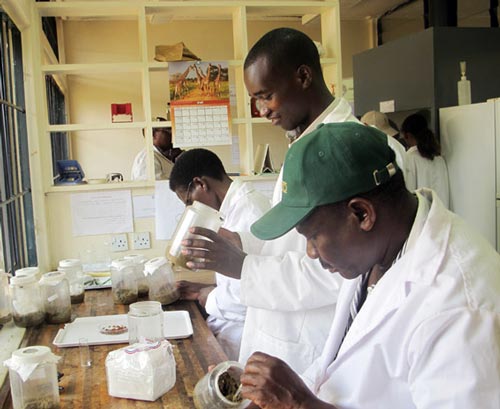 Insect Resistant Maize for Africa (IRMA) and its sister project, Water Efficient Maize for Africa (WEMA), have embarked on an initiative to train personnel in mass rearing of insects and develop rearing facilities. These insects are used in evaluation of maize resistance to insect damage. Through the initiative, 12 technicians from Kenya, Uganda, Tanzania, and Mozambique participated in a Stem Borer Mass Rearing Training Course held at the Kenya Agricultural Research Institute (KARI)-Katumani, Machakos, Kenya during 25 March-05 April 2012.
Insect Resistant Maize for Africa (IRMA) and its sister project, Water Efficient Maize for Africa (WEMA), have embarked on an initiative to train personnel in mass rearing of insects and develop rearing facilities. These insects are used in evaluation of maize resistance to insect damage. Through the initiative, 12 technicians from Kenya, Uganda, Tanzania, and Mozambique participated in a Stem Borer Mass Rearing Training Course held at the Kenya Agricultural Research Institute (KARI)-Katumani, Machakos, Kenya during 25 March-05 April 2012.
The course was co-organized by CIMMYT, the African Agricultural Technology Foundation (AATF), KARI, and Monsanto. It designed to empower technicians from the WEMA project partner countries to undertake mass rearing of stem borers; establish and manage mass rearing facilities; and effectively conduct research on stem borers in field trials. It provided hands-on training, focusing on establishment of mass rearing units, facilities, equipment, diet ingredients, and lab safety regulations; colony establishment and maintenance, diet sorting, preparation and infestation; and management of stem borer larvae, pupae, moths, and eggs.
Underscoring the importance of the course, CIMMYT maize breeder Stephen Mugo noted that insect pests had become major problems in maize production, affecting 46% of the global maize growing area and destroying 25% of the global crop annually, equivalent to 52 million metric tons valued at USD 5.7 billion. Farmers trying to control the pests across the globe use USD 550 million worth of insecticides annually. Further, over 60% of these losses occur in the tropics where environmental conditions are favorable for stem borers year round.
Explaining the inclusion of insect protection in WEMA, Mugo noted that water stressed maize suffers more from stem borer infestation. “Drought and insect damage may lead to crop failure. The development of products with combined drought tolerance and insect protection would greatly enhance the benefits to smallholder maize growers in Africa.”
Tadele Tefera, CIMMYT maize entomologist and one of the course facilitators, pointed out that each of the four control methods for maize stem borer—biological, chemical, cultural and host plant resistance (HPR)—has its own limitations. However, considering that for reasons of costs and availability of pest control methods farmers often use no control measures at all, HPR is the easiest control method for subsistence farmers to adopt and use as the resistance is embedded in the seed. However, HPR needs investment in germplasm development and screening, a process that requires insect pests, hence the need to establish insect mass rearing facilities.
Stella Adupo, a participant from Uganda, exuded confidence that she had acquired adequate skills to undertake mass rearing of insects. Like other participants, she promised to establish a mass rearing facility, at the National Crops Resources Research Institute (NaCCRI), Namulonge, Uganda.
Speaking at the end of the course, Charles Kariuki, center director of KARI-Katumani, noted that food insecurity is partly due to lack of technical personnel to develop suitable technology and to advise farmers. “You have now gained this very important technical know-how on mass rearing. It is important that you apply this knowledge. More importantly, you must endeavor to pass the knowledge to others, at least train 2-3 people on insect mass rearing at your institution for greater impact.”
He advised the participants to read more on insect mass rearing to expand their knowledge and understand the discipline, and become more professional and efficient in their work. He thanked CIMMYT for its support in research and capacity-building.
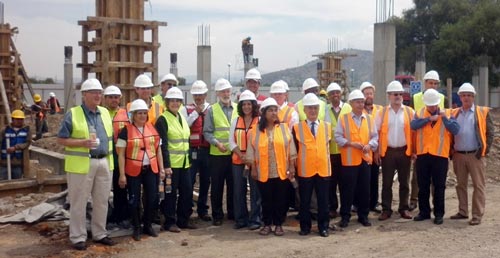
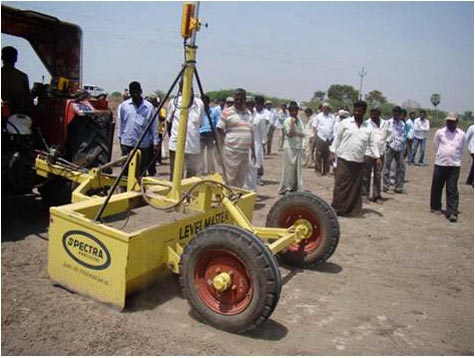 Discussions covered laser leveling, direct-seeded rice, zero-till maize, conservation agriculture machinery, the turbo seeder for residue management, weed management, pest management, cultivar choices, potential diversification options using resource-conserving technologies, and the potential for diversification and the adoption of water-wise practices to make more efficient and productive use of irrigation water. The operation and benefits of conservation agriculture machinery, including the laser land leveler, zero-till multi-crop planter, and turbo seeder, were demonstrated and explained. Farmers who have adopted the technologies shared their views and encouraged others to adopt.
Discussions covered laser leveling, direct-seeded rice, zero-till maize, conservation agriculture machinery, the turbo seeder for residue management, weed management, pest management, cultivar choices, potential diversification options using resource-conserving technologies, and the potential for diversification and the adoption of water-wise practices to make more efficient and productive use of irrigation water. The operation and benefits of conservation agriculture machinery, including the laser land leveler, zero-till multi-crop planter, and turbo seeder, were demonstrated and explained. Farmers who have adopted the technologies shared their views and encouraged others to adopt.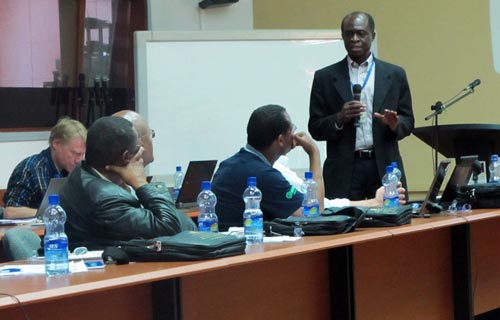 During 26-28 March 2012, CIMMYT scientists, partners, and collaborators met in Addis Ababa, Ethiopia, for the Inception Planning Workshop of the NuME project. NuME (Nutritious Maize for Ethiopia) is a new five-year USD 13 million project that aims to significantly reduce malnutrition, especially among young children, and increase food security and household income of resource-poor smallholder farmers in Ethiopia through the widespread adoption, production, and utilization of quality protein maize (QPM). QPM contains more than twice as much lysine and tryptophan as conventional maize, giving its protein a nutritive value that is roughly 90% that of milk.
During 26-28 March 2012, CIMMYT scientists, partners, and collaborators met in Addis Ababa, Ethiopia, for the Inception Planning Workshop of the NuME project. NuME (Nutritious Maize for Ethiopia) is a new five-year USD 13 million project that aims to significantly reduce malnutrition, especially among young children, and increase food security and household income of resource-poor smallholder farmers in Ethiopia through the widespread adoption, production, and utilization of quality protein maize (QPM). QPM contains more than twice as much lysine and tryptophan as conventional maize, giving its protein a nutritive value that is roughly 90% that of milk.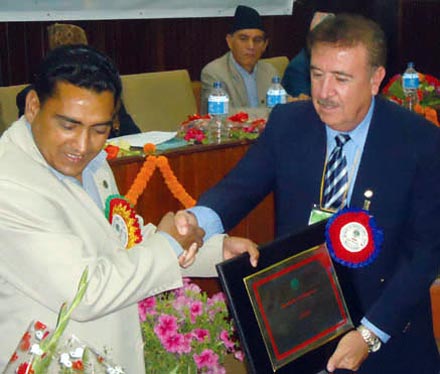 Receiving the prize on behalf of CIMMYT, Nepal country representative Guillermo Ortiz-Ferrara thanked the Society for the recognition. “On behalf of the director general of CIMMYT, Dr. Thomas Lumpkin, the center’s management, and colleagues who have been based in Nepal and the region for more than 26 years, we thank SAS-N for this great honor,” he said. “I would like to give special thanks to the government of Nepal and the MoAC for hosting CIMMYT’s regional office. Finally, we thank the many government and non-government organizations for their long-standing partnership and collaboration.”
Receiving the prize on behalf of CIMMYT, Nepal country representative Guillermo Ortiz-Ferrara thanked the Society for the recognition. “On behalf of the director general of CIMMYT, Dr. Thomas Lumpkin, the center’s management, and colleagues who have been based in Nepal and the region for more than 26 years, we thank SAS-N for this great honor,” he said. “I would like to give special thanks to the government of Nepal and the MoAC for hosting CIMMYT’s regional office. Finally, we thank the many government and non-government organizations for their long-standing partnership and collaboration.”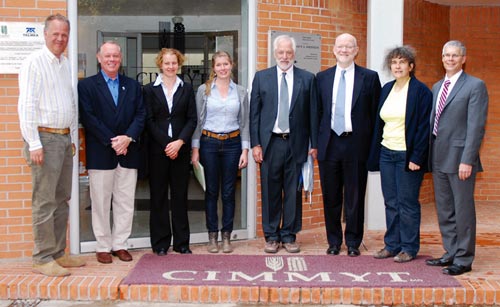 Senior management and center scientists welcomed Chris Elias, the new President of Global Development of the Bill & Melinda Gates Foundation, to CIMMYT headquarters on 30 March 2012, providing among other things an introduction to major programs. Elias’ background includes experience in the global non-profit health sector and most recently as CEO of PATH, a nongovernmental organization whose portfolio includes solutions for AIDS, tuberculosis, and malaria. David Bergvinson, Senior Program Officer for Science & Technology, for the Foundation accompanied Elias to CIMMYT.
Senior management and center scientists welcomed Chris Elias, the new President of Global Development of the Bill & Melinda Gates Foundation, to CIMMYT headquarters on 30 March 2012, providing among other things an introduction to major programs. Elias’ background includes experience in the global non-profit health sector and most recently as CEO of PATH, a nongovernmental organization whose portfolio includes solutions for AIDS, tuberculosis, and malaria. David Bergvinson, Senior Program Officer for Science & Technology, for the Foundation accompanied Elias to CIMMYT.
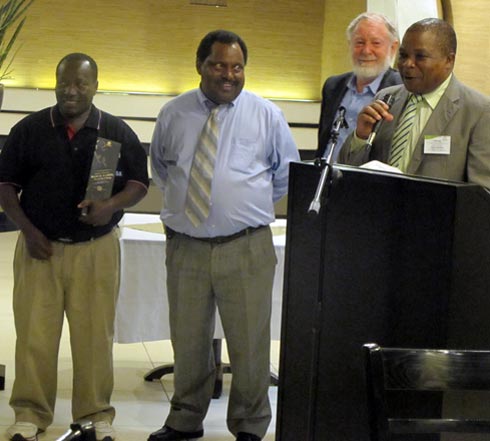 Speaking at the SIMLESA’s second “birthday party,” Joana Hewitt, chairperson of the ACIAR Commission for International Agricultural Research, reiterated the Australian government’s commitment to long-term partnerships with African governments. Participants also heard of the new SIMLESA Program in Zimbabwe, focusing on crop-livestock interactions. During the dinner, Kenya and Mozambique were recognized for their efforts in promoting and strengthening local innovation platforms.
Speaking at the SIMLESA’s second “birthday party,” Joana Hewitt, chairperson of the ACIAR Commission for International Agricultural Research, reiterated the Australian government’s commitment to long-term partnerships with African governments. Participants also heard of the new SIMLESA Program in Zimbabwe, focusing on crop-livestock interactions. During the dinner, Kenya and Mozambique were recognized for their efforts in promoting and strengthening local innovation platforms.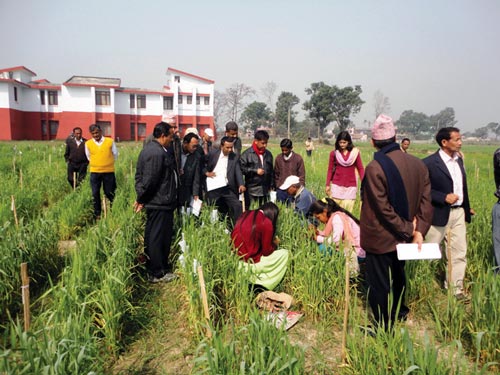 A training program on wheat participatory variety selection (PVS) was held in Nepal during 28-29 February 2012. Organized by the National Wheat Research Program (NWRP), Bhairahawa, Nepal Agriculture Research Council (NARC) and CIMMYT, the event attracted 17 scientists, technical officers and seed technicians from NARC’s research stations and private seed companies. The two-day training program focused on current challenges of wheat breeding and production in Nepal, wheat diseases, and participatory selection of varieties.
A training program on wheat participatory variety selection (PVS) was held in Nepal during 28-29 February 2012. Organized by the National Wheat Research Program (NWRP), Bhairahawa, Nepal Agriculture Research Council (NARC) and CIMMYT, the event attracted 17 scientists, technical officers and seed technicians from NARC’s research stations and private seed companies. The two-day training program focused on current challenges of wheat breeding and production in Nepal, wheat diseases, and participatory selection of varieties.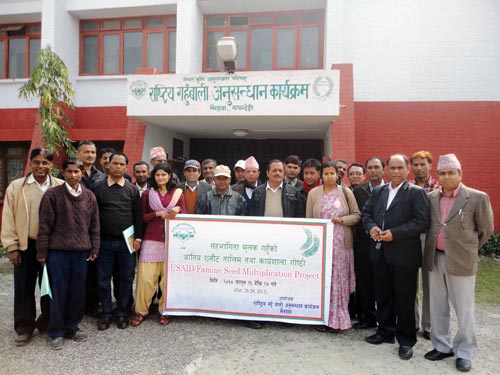 NARC scientists SR Upadhyay and NR Gautam explained the steps of participatory selection and participants scored varieties in the mother trial.
NARC scientists SR Upadhyay and NR Gautam explained the steps of participatory selection and participants scored varieties in the mother trial.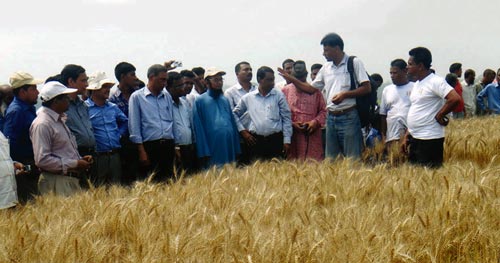
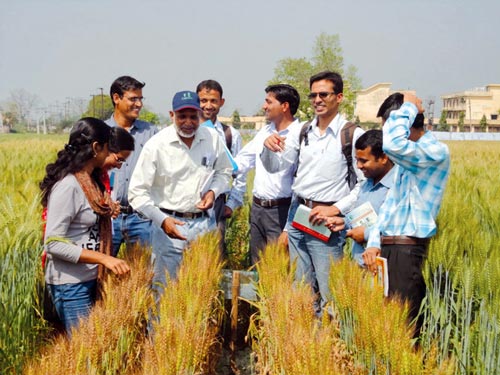 A one-day field training on scoring for spot blotch was organized on 17 March 2012 at the Borlaug Institute for South Asia (BISA) experiment station in Pusa, Bihar. Participants were 16 young scientists and students of Rajendra Agricultural University (RAU) and the Regional Station of Indian Agriculture Research Institute (IARI). Renowned pathologist Professor Ramesh Chand, Banaras Hindu University, was the main resource person, supported by Dr. Rajeev Kumar (RAU) and Raj Kumar Jat (CIMMYT).
A one-day field training on scoring for spot blotch was organized on 17 March 2012 at the Borlaug Institute for South Asia (BISA) experiment station in Pusa, Bihar. Participants were 16 young scientists and students of Rajendra Agricultural University (RAU) and the Regional Station of Indian Agriculture Research Institute (IARI). Renowned pathologist Professor Ramesh Chand, Banaras Hindu University, was the main resource person, supported by Dr. Rajeev Kumar (RAU) and Raj Kumar Jat (CIMMYT).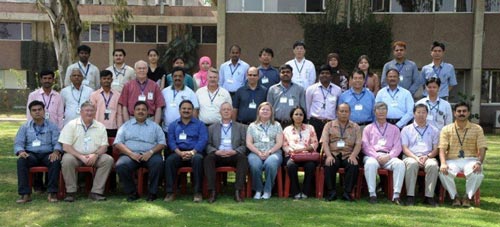
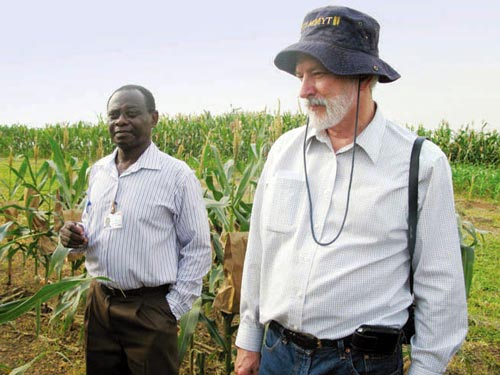 On 15 February 2012, CIMMYT director general Tom Lumpkin met with his peer, Nteranya Sanginga, at the headquarters of the International Institute of Tropical Agriculture (IITA) in Ibadan, Nigeria. Accompanied by CIMMYT-Regional Liaison Officer, Wilfred Mwangi, Lumpkin also interacted with IITA maize breeders Baffour Badu-Apraku, Abebe Menkir, and Sam Ajala, as well as IITA socioeconomist Tahirou Abdoulaye.
On 15 February 2012, CIMMYT director general Tom Lumpkin met with his peer, Nteranya Sanginga, at the headquarters of the International Institute of Tropical Agriculture (IITA) in Ibadan, Nigeria. Accompanied by CIMMYT-Regional Liaison Officer, Wilfred Mwangi, Lumpkin also interacted with IITA maize breeders Baffour Badu-Apraku, Abebe Menkir, and Sam Ajala, as well as IITA socioeconomist Tahirou Abdoulaye.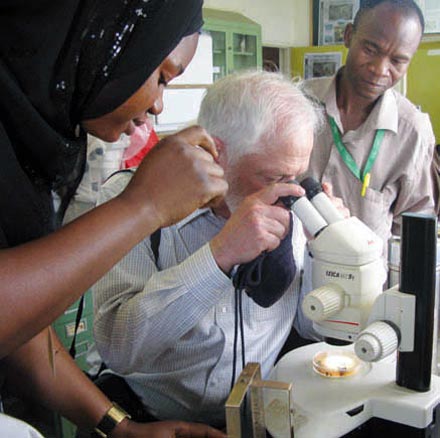 Lumpkin and Mwangi visited IITA maize trials, including those of maize bred for resistance to the parasitic flowering plant, Striga spp., through crosses with teosinte. Attaching to sprouting maize seedlings, Striga saps nutrients and imparts a toxin that slows growth. It causes damage to Africa’s maize estimated in the billions of dollars and affects as much as 40 million hectares of food crops across the region. Teosinte belongs to the same genus as maize and is considered the crop’s predecessor.
Lumpkin and Mwangi visited IITA maize trials, including those of maize bred for resistance to the parasitic flowering plant, Striga spp., through crosses with teosinte. Attaching to sprouting maize seedlings, Striga saps nutrients and imparts a toxin that slows growth. It causes damage to Africa’s maize estimated in the billions of dollars and affects as much as 40 million hectares of food crops across the region. Teosinte belongs to the same genus as maize and is considered the crop’s predecessor.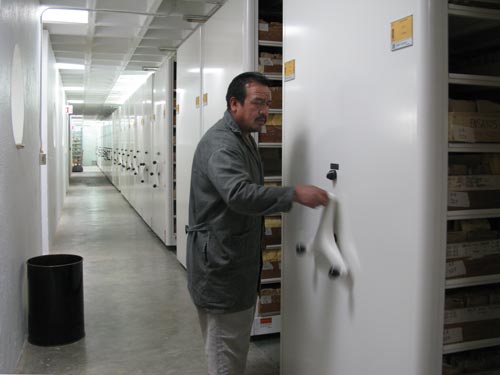 All of us who work at CIMMYT have noticed its recent growth—new faces, new projects, and new facilities being constructed at El Batán and elsewhere. All of this means more research is getting done, and, inparticular, the global maize program is using and producing more breeding materials.
All of us who work at CIMMYT have noticed its recent growth—new faces, new projects, and new facilities being constructed at El Batán and elsewhere. All of this means more research is getting done, and, inparticular, the global maize program is using and producing more breeding materials. Tunga Silvar grows maize to feed his wife and fourgrandchildren on about 0.5 hectares of land in Mawanga, Zimbabwe, a hilly area some 45 kilometers northeast of Harare. Like otherfarmers in the region, he is acutely aware of the value of nitrogen fertilizer, continually juggles his limited household financesto get it, and is poorer and hungrier when he can’t. “We used to sell maize, but in the last five years we haven’t been able to do so,” saysSilvar. “I had to pay school fees for my grandchildren, so I couldn’t buy fertilizer. Fertilizer is very important, especially in our type of soil. If you don’t apply it, youcan barely harvest anything.”
Tunga Silvar grows maize to feed his wife and fourgrandchildren on about 0.5 hectares of land in Mawanga, Zimbabwe, a hilly area some 45 kilometers northeast of Harare. Like otherfarmers in the region, he is acutely aware of the value of nitrogen fertilizer, continually juggles his limited household financesto get it, and is poorer and hungrier when he can’t. “We used to sell maize, but in the last five years we haven’t been able to do so,” saysSilvar. “I had to pay school fees for my grandchildren, so I couldn’t buy fertilizer. Fertilizer is very important, especially in our type of soil. If you don’t apply it, youcan barely harvest anything.”
 Late and erratic rainfall in Zimbabwe has many farmers facing the prospect of poor harvests. The current hardships from drought though may furnish some hopefor farmers. New drought tolerant varieties are being tested in on-farm trials under farmer management. Many of the trials are experiencing drought stress—aperfect opportunity to identify the best varieties for such harsh conditions. A recent visit to on-farm trials in the Murewa District of Zimbabwe showed many new drought tolerant products performing well. Local farmer Sailas Ruswa is growing a trial and was enthusiastic about what he saw: some varieties showedsigns of severe drought stress, but a few were holding up well and were expected to produce good yields.
Late and erratic rainfall in Zimbabwe has many farmers facing the prospect of poor harvests. The current hardships from drought though may furnish some hopefor farmers. New drought tolerant varieties are being tested in on-farm trials under farmer management. Many of the trials are experiencing drought stress—aperfect opportunity to identify the best varieties for such harsh conditions. A recent visit to on-farm trials in the Murewa District of Zimbabwe showed many new drought tolerant products performing well. Local farmer Sailas Ruswa is growing a trial and was enthusiastic about what he saw: some varieties showedsigns of severe drought stress, but a few were holding up well and were expected to produce good yields.